
New York 1960
the San Francisco Museum of Modern Art has a reputation for producing landmark photography exhibits. I saw the retrospective, Diane Arbus Revelations, a decade ago and it made a lasting impression on me. I was impressed by the thoughtfulness with which it was curated and produced. The exhibit featured 200 or so photographs, including many that had never been seen publicly. There was also a mockup of her darkroom complete with Nikon F and Rollei cameras, developing trays and marked contact sheets, all lit by safelight.
The soon-to-close Garry Winogrand exhibit at SFMOMA presents an equally comprehensive look at this photographer’s work spanning some thirty years. Guest curated by Leo Rubinfien, along with Erin O’Toole and Sarah Greenough, the exhibition contains many never-seen-before images. Winogrand died of cancer in 1984 at the age of 56 leaving behind some 250,000 frames of unedited film. Approximately 90 of the 200 plus photographs in the exhibit have been printed for the first time. Text1 at the entrance explains the provenance and preparation of the photographs on display. Prints made posthumously are all silver gelatin. There are no inkjet prints in the exhibit.
Free-standing glass topped island display cases in the gallery rooms provide insight into the photographer’s life. There are letters, family photos, magazines with work for hire, an application for a Guggenheim Fellowship (with endorsement from Diane Arbus) and contact sheets. The contact sheets, which bear his editing marks, offer a telling view of his working method and selection process.
The photographs are presented by period (Down From the Bronx, A Student of America, Boom and Bust) and show the development of Winogrand as a photographer. Text throughout the exhibit reminds us of events of each period.

New York ca.1958
Winogrand was twenty years old when he discovered photography as his calling. At that time, the country was relieved to be finished with WW II and the postwar boom of the fifties, for many families, was the beginning of the move from cities to suburbs. Uplifted by the promise of peace and growing prosperity, wartime industries returned to serving the needs of the American public and technological advances born of the war found their way to consumer products and services. Families enjoyed leisure time together, rock and roll was born, and television presented a view of life that now only exists in Norman Rockwell paintings.
As the fifties gave way to the sixties, the innocence of the earlier decade was lost when president John F, Kennedy was assassinated in November of 1963. Throughout the sixties the US was embroiled in the controversial Vietnam War that tore the country apart. While political riots plagued college campuses, reaching a crescendo at Kent State University2 in 1970, social riots tore through major cities in the sixties. Assassination continued through the decade with Senator Robert Kennedy and civil rights leader, Martin Luther King both losing their lives in 1968, Still, president Lyndon Johnson promised the country “A Great Society.”
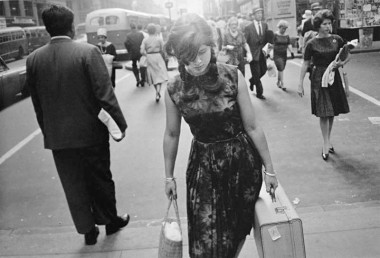
New York ca. 1960
The civil rights movement culminated in the passage of the Civil Rights Act of 1964 banning discrimination based on race, sex or religion. The Cold War became ever more frigid and the possibility of nuclear annihilation was tangible (in high school I had a neighbor who built a bomb shelter). The role of the majority of women was as housewife and professional career choices for them were limited. One older female friend recently said, “if you wanted to work, you were either a secretary, receptionist, nurse or teacher.”
By the middle of the decade “hippies” were an established counterculture. They opposed established political traditions, hated the Vietnam War, and advocated peace, love and spiritual enlightenment. Since the 1960s, many aspects of hippie culture have been assimilated by mainstream society. From the Banlon and polyester days of the early sixties, when canned vegetables were a staple of American households, the back to the earth movement began. Euell Gibbons preached natural foods and we learned how to talk to our houseplants in the book, The Secret Life of Plants. We learned that you are what you eat and health and fitness entered the American culture. Organic farms and cooperatives sprung up in rural areas across the country. Celestial Seasonings introduced herbal tea and natural fiber clothing began replacing synthetics. The Beatles launched the first wave of the British Invasion and forever changed music and popular culture. The armchair traveler who had relied on National Geographic magazine for insight into foreign lands and cultures was replaced by a peripatetic society as air travel brought faraway places within reach of those who could afford it. For the rest, television provided a window to the world and for the first time we saw the brutal realities of war as we sat in our living room.
1967 marked the first major exhibit of Winogrand’s work. Along with Diane Arbus and Lee Friedlander, the New Documents exhibit at the Museum of Modern Art in New York brought attention to the three photographers and forever linked them together.
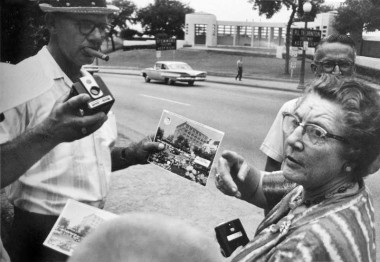
Dealy Plaza, Dallas 1964
“I am surprised that my prints sell. They’re not pretty. They’re not those kind of pictures that people can easily put on their wall. They’re not that window on to a nice landscape or something.”
From the beginning Winogrand’s work showed few ties to the documentary traditions of the New York Photo League. Ironically, he was friends with Dan Weiner3 and considered him a mentor. It was Weiner who introduced him to Walker Evans’s American Photographs, the book that made such an impression on the young photographer. His eventual break from commercial work around 1969 allowed him to concentrate on his art and evolve into the pivotal photographer of the Twentieth Century that he ultimately became. At that time there were few, if any, galleries devoted to selling photography. Those art galleries and museums that did deal in the medium presented the established names (Weston, Steiglitz, Adams, Strand, etc.). The means by which “art photographers” supported themselves was through stipends from teaching assignments and grants, which together. barely provided subsistence living.

Los Angeles 1980-83
“I don’t have to have any storytelling responsibility to what I’m photographing. I have a responsibility to describe it well.”
Though the photographs in this exhibition should be viewed in context of their time, to say they are only of a historical importance is wrong. Winogrand was not a photojournalist. This work that he is best known for is not documentary photography. He felt no responsibility to be socially conscious. He was not interested in telling stories (although much of the time his pictures did tell stories for many viewers). He was not trying to make the world a better place through his photography.
In her San Francisco Chronicle review, Caille Millner states that Winogrand “was famous for never asking people permission before taking their photographs” and suggests that a generation of male photographers idolized him for his bravado. What Ms. Millner missed is that engaging people before taking their photo results in portraits, not candid street photography (a term which Winogrand disliked). When you ask someone to take a photo of them, they will most assuredly pose for you. Those people who accuse Winogrand
of being brash or pushy mistake his intentness of purpose. Exploring
photographic problems was a purely selfish pursuit and all consuming for him.

Los Angeles International Airport, late 1970’s
“We know too much about how pictures look and should look. How do you get around making those pictures again and again?”
In the exhibit the pictures change after he received his Guggenheim Fellowship in 1964. The lyrical approach to image making that he inherited from Walker Evans and Robert Frank gives way to complex, sometimes chaotic frames. This was one of the photographic problems he was exploring: how much information can a photograph contain before the content overwhelms the form? The 50mm “normal” lens was abandoned in favor of something wider; first 35mm then later, 28mm. This change of technique is striking in the presentation of the photographs.
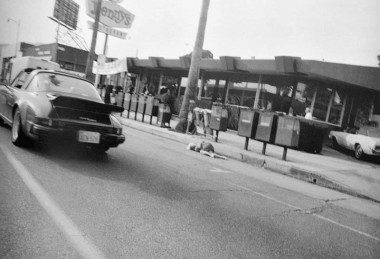
Los Angeles 1980-83
“Frame in terms of what you want to have in the picture, not about making a nice picture, that anybody can do.”
Garry Winogrand was first to use many of the devices that modern street photographers take for granted today. By using a wide-angle lens, not only could he include more information in a frame, he also became part of the life of the street instead of being an observer from afar. True to the genre, today street photographers rarely use long focal lengths or even carry telephoto lenses. Before Winogrand, horizon lines in photographs were parallel to the edge of the frame. The tilted frame that is so commonplace nowadays was one of his “experiments” as he explored the possibilities of what photographs were and could be. The seemingly simple, snapshot look of his photos brings attention to his subjects and has rarely been done as eloquently. His commonplace subject matter was previously thought too mundane to be worthy of photographing; yet it is Winogrand’s process of selection that brings focus to the nature of our society itself. In order to not suggest specific meaning to his photographs, he titled them using only place and year. Like Cartier-Bresson, compositions were made in the viewfinder and negatives were never cropped when printed.
When still photography was introduced it was hailed as a medium that could capture a moment with irrevocable truth to be preserved for eternity. Winogrand knew that the tie between a two-dimensional photograph and what it depicted was questionable at best. The simple act of framing a selection of a scene could create new relationships between the elements of a photograph that did not exist in reality.
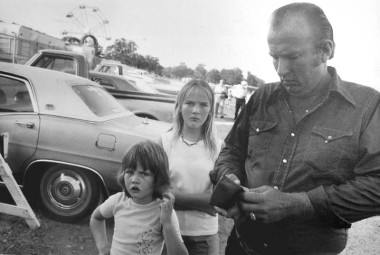
La Grange, Texas 1977
“When I’m photographing I see life.”
The early photographs are easy to relate to and bear a closer resemblance to existing documentary traditions in terms of subject and framing. While distinct from that of his contemporaries, they suggest the direction in which he was heading. The early photographs present scenes and subjects without washing them in sentimentality or opinion, or over embellishing them with style or form. By the time Stock Photographs was published in 1980, images might consist of a diagonal slash of content across the frame, or a somewhat blurred subject harshly lit by flash. Yet to say that certain stylistic approaches were indicative of a period would be untrue. The later work is certainly more somber…often more radical in composition. Early subject-dominated photographs tended to be carefree and detached. Later on they became introspective, as if promises had gone unfulfilled. Subjects seem to be involved with their own inner thoughts and problems. Was it Winogrand who changed, or was it the world? If he had a premonition about his illness, it would be difficult to pinpoint when it began to influence his photography.
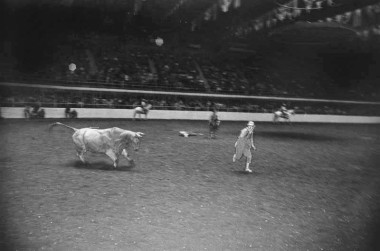
Rodeo, Fort Worth 1975
Garry Winogrand has often been derided for not editing the work he was producing as the 1970’s got underway, leaving thousands upon thousands of images that he never even looked at. Even some of his strongest supporters, like John Szarkowski, felt that his talent had declined. Winogrand would rather be on the street taking photographs than looking at those he had already made. Photography in itself is a process of selection. In the later years shooting may have been as much as he was willing to commit to, leaving the final selection to others and for posterity to judge in the end. With a retrospective this large and many of the images never actually selected by Winogrand himself, we can only guess as to whether or not it represents a valid statement of his work. Credit is due to the curators for even attempting such a monumental task. To be sure, there are some less than strong images in the later period. Weeding out a third of the pictures would result in a stronger collection of images, but it would not tell us as much about the evolution of the photographer. A smaller exhibition would not include the wrong turns and experimentation that all artists deal with.
Looking back at videos of him working the street we can only marvel at how he made photography look so simple, yet created a body of work that is so complex and groundbreaking for its time that it created a whole new way of making and looking at photographs. His most lasting legacy must certainly be the vast archive of photography he left showing the sixties and seventies in America with honesty and an intensely personal vision that is unique. We will never know whether he was fooling us all when he said he took pictures to see what things looked like to a camera. If Winogrand were still alive, he would probably tell us, “look at the pictures, what do you see?”
We hope that SFMOMA will mount a Lee Friedlander retrospective in the coming decade, thus completing the trilogy of the 1967
New Documents exhibit that launched the careers of Diane Arbus, Lee Friedlander and Garry Winogrand. On June 2 the San Francisco Museum of Modern Art will close for two years for renovation. The Garry Winogrand exhibit will travel to Washington DC, New York, Paris and Madrid. The catalog is available as hard cover or paperback from the museum’s online store at
www.sfmoma.org.
NOTE ON THE QUOTES
These quotes from Garry Winogrand are mostly transcribed from a two-part interview conducted by Bill Moyers in 1982 (see “Garry Winogrand” post in Archive for links), although they have appeared in other writings of and about the photographer. The Winogrand doctrine was revolutionary for its time: ” …there isn’t a photograph in the world that has any narrative ability. Any of ’em. They do not tell stories – they show you what something looks like. To a camera.” “All a photograph ever does is describe light on surface, that’s all there is.” To this day, people still get contentious when you tell them that photographs don’t tell stories — that a narrative involves the passage of time, not a frozen slice of it. While Winogrand is generally acknowledged as the author of this radical philosophy, I have recently revised my thinking. John Szarkowski’s book, The Photographer’s Eye, was based on his 1964 Museum of Modern Art exhibit of the same name, and first published as a book in 1966. The volume is divided into five sections with an explanation of each at the front of the book: The Thing Itself, The Detail, The Frame, Time and Vantage Point. Bits of text in the book bear a striking semblance to the Winogrand doctrine; ” …photography has never been successful at narrative. It has in fact seldom attempted it.” “…the thing that happens at the decisive moment is not a dramatic climax but a visual one. The result is not a story, but a picture.” This is the same language used by Winogrand. It appears that this way of thinking about photographs was something that evolved as part of the interaction between Winogrand, Szarkowski, Joel Meyerowitz, Tod Papageorge and others in that circle during the mid-sixties. Joel Meyerowitz4; says,” I can tell you that neither of us (Winogrand and he) had anything intelligent to say about photographs back then, a grunt of surprise or saying ‘that’ s interesting’, or ‘that’ s tough’…until John showed us what might be part of the dialogue we were all lost.” He adds, ” Szarkowski was the mentor to us all, and I firmly believe that his wisdom, through his exhibitions, writings, and private talks with each of us shaped the thinking of my and Garry’s generation.”
FOOTNOTES
1) The majority of photographs in this exhibition were printed by Winogrand or under his supervision by Thomas Consilvio or Paul McDonough. The rest were made after his death and unless otherwise noted, were printed in 2012-2013 in Tuscon, Arizona by Teresa Engle Schirmer. All are gelatin silver prints.In his last years, Winogrand put off developing his film and editing his contact sheets in favor of shooting. At his death he left behind approximately 2,500 rolls of exposed but undeveloped film and 4,100 more that he had processed but not reviewed, representing most of his production during the last six years of his life. Winogrand had allowed others to edit his work and print his photographs, however, and in preparing for its posthumous 1988 exhibition Garry Winogrand, the Museum of Modern Art, New York, develped. proofed and edited the work he left behind. That show included a small group of prints made by Consilvio from late images selected by John Szarkowski, director of MoMA’s department of photography, and by Winogrand’s friends and fellow photographers Tod Papageorge and Thomas Roma.
Many earlier Winogrand photographs also remained unprinted at his death. For the present exhibition, therefore, guest curator Leo Rubenfien undertook a two-year review of the bulk of 22,000-odd contact sheets in Winogrand’s archive at the Center for Creative Photography at the University of Arizona, Tuscon. Over ninety posthumous prints made from Rubinfien’s selections and drawn from the full span of Winogrand’s career are on view here. The labels for these prints indicate whether Winogrand marked a given frame on its contact sheet, suggesting that he found it to be of interest.
2) On May 4, 1970, four Kent State University students were killed and nine injured when members of the Ohio National Guard opened fire during a demonstration protesting the Vietnam War. John Filo’s iconic photograph of the tragedy won a Pulitzer Prize. (Wikipedia).
3) Dan Weiner (1919-1959) studied painting at the Art Students League and Pratt Institute, eventually accepting a job as a commercial photographer. He joined the New York Photo League and developed an affinity for the work of Dorothea Lange, Walker Evans, and Russell Lee. Following World War II, he pursued work as a photojournalist, refining his belief that the photographer has a moral responsibility to illuminate social ills and to comment on significant events in history. Weiner’s life was tragically ended by a plane crash while he was on assignment in 1959. (www.robertmann.com).
4) Personal communication.
REFERENCES
Evans, Walker, essay by Linclon Kirstein. American Photographs. 75th anniversary ed. New York: The Museum of Modern Art. 2012.Kotz, Liz. “Damaged.” 21-28: Coleman, A.D. “Diane Arbus, Lee Friedlander, and Garry Winogrand at Century’s End.” 31-37. The Social Scene. Ed. Stephanie Emerson. Los Angeles. The Museum of Contemporary Art. 2000.
Lifson, Ben. “Garry Winogrand’s American Comedy.” Aperture 86: 32-39. 1982.
Rubinfein, Leo. “Garry Winogrand’s Republic.” 13-61. Garry Winogrand. Ed. Leo Rubinfein. San Francisco: San Francisco Museum of Modern Art. New Haven and London: Yale University Press. 2013.
Szarkowski, John. The Photographer’s Eye. New York: The Museum of Modern Art, 1966.
Winogrand, Garry, introduction by Tod Papageorge. Public Relations. 2nd ed. New York: The Museum of Modern Art. 1977.
Greg Allikas, May 2013
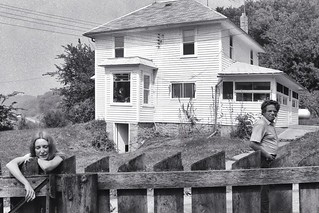
Eileen and Garry Winogrand, Woodman, Wisconsin 1973
posted by Greg Allikas, May 31, 2013
New York 1960
New York ca.1958
New York ca. 1960
Dealy Plaza, Dallas 1964
“I am surprised that my prints sell. They’re not pretty. They’re not those kind of pictures that people can easily put on their wall. They’re not that window on to a nice landscape or something.”
Los Angeles 1980-83
“I don’t have to have any storytelling responsibility to what I’m photographing. I have a responsibility to describe it well.”
of being brash or pushy mistake his intentness of purpose. Exploring
photographic problems was a purely selfish pursuit and all consuming for him.
Los Angeles International Airport, late 1970’s
“We know too much about how pictures look and should look. How do you get around making those pictures again and again?”
Los Angeles 1980-83
“Frame in terms of what you want to have in the picture, not about making a nice picture, that anybody can do.”
La Grange, Texas 1977
“When I’m photographing I see life.”
Rodeo, Fort Worth 1975
NOTE ON THE QUOTES
FOOTNOTES
1) The majority of photographs in this exhibition were printed by Winogrand or under his supervision by Thomas Consilvio or Paul McDonough. The rest were made after his death and unless otherwise noted, were printed in 2012-2013 in Tuscon, Arizona by Teresa Engle Schirmer. All are gelatin silver prints.In his last years, Winogrand put off developing his film and editing his contact sheets in favor of shooting. At his death he left behind approximately 2,500 rolls of exposed but undeveloped film and 4,100 more that he had processed but not reviewed, representing most of his production during the last six years of his life. Winogrand had allowed others to edit his work and print his photographs, however, and in preparing for its posthumous 1988 exhibition Garry Winogrand, the Museum of Modern Art, New York, develped. proofed and edited the work he left behind. That show included a small group of prints made by Consilvio from late images selected by John Szarkowski, director of MoMA’s department of photography, and by Winogrand’s friends and fellow photographers Tod Papageorge and Thomas Roma.
Many earlier Winogrand photographs also remained unprinted at his death. For the present exhibition, therefore, guest curator Leo Rubenfien undertook a two-year review of the bulk of 22,000-odd contact sheets in Winogrand’s archive at the Center for Creative Photography at the University of Arizona, Tuscon. Over ninety posthumous prints made from Rubinfien’s selections and drawn from the full span of Winogrand’s career are on view here. The labels for these prints indicate whether Winogrand marked a given frame on its contact sheet, suggesting that he found it to be of interest.
2) On May 4, 1970, four Kent State University students were killed and nine injured when members of the Ohio National Guard opened fire during a demonstration protesting the Vietnam War. John Filo’s iconic photograph of the tragedy won a Pulitzer Prize. (Wikipedia).
3) Dan Weiner (1919-1959) studied painting at the Art Students League and Pratt Institute, eventually accepting a job as a commercial photographer. He joined the New York Photo League and developed an affinity for the work of Dorothea Lange, Walker Evans, and Russell Lee. Following World War II, he pursued work as a photojournalist, refining his belief that the photographer has a moral responsibility to illuminate social ills and to comment on significant events in history. Weiner’s life was tragically ended by a plane crash while he was on assignment in 1959. (www.robertmann.com).
4) Personal communication.
REFERENCES
Evans, Walker, essay by Linclon Kirstein. American Photographs. 75th anniversary ed. New York: The Museum of Modern Art. 2012.Kotz, Liz. “Damaged.” 21-28: Coleman, A.D. “Diane Arbus, Lee Friedlander, and Garry Winogrand at Century’s End.” 31-37. The Social Scene. Ed. Stephanie Emerson. Los Angeles. The Museum of Contemporary Art. 2000.
Lifson, Ben. “Garry Winogrand’s American Comedy.” Aperture 86: 32-39. 1982.
Rubinfein, Leo. “Garry Winogrand’s Republic.” 13-61. Garry Winogrand. Ed. Leo Rubinfein. San Francisco: San Francisco Museum of Modern Art. New Haven and London: Yale University Press. 2013.
Szarkowski, John. The Photographer’s Eye. New York: The Museum of Modern Art, 1966.
Winogrand, Garry, introduction by Tod Papageorge. Public Relations. 2nd ed. New York: The Museum of Modern Art. 1977.
Greg Allikas, May 2013
Eileen and Garry Winogrand, Woodman, Wisconsin 1973
posted by Greg Allikas, May 31, 2013
Published by
admin